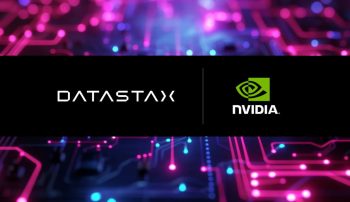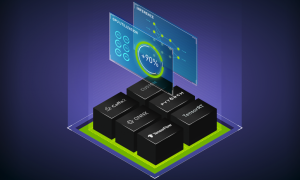
DataStax, the generative AI data company, has announced it is supporting enterprise retrieval-augmented generation (RAG) use cases by integrating the new NVIDIA NIM inference microservices and NeMo Retriever microservices with Astra DB to deliver high-performance RAG data solutions for superior customer experiences.
With this integration, users will be able to create instantaneous vector embeddings 20x faster than other popular cloud embedding services and benefit from an 80% reduction in cost for services.
Organisations building generative AI applications face the daunting technological complexities, security, and cost barriers associated with vectorising both existing and newly acquired unstructured data for seamless integration into large language models (LLMs). The urgency of generating embeddings in near-real time and effectively indexing data within a vector database on standard hardware further compounds these challenges.
“In today’s dynamic landscape of AI innovation, RAG has emerged as the pivotal differentiator for enterprises building genAI applications with popular large language frameworks,” said Chet Kapoor, Chairman and CEO at DataStax. “With a wealth of unstructured data at their disposal, ranging from software logs to customer chat history, enterprises hold a cache of valuable domain knowledge and real-time insights essential for generative AI applications, but still face challenges. Integrating NVIDIA NIM into RAGStack cuts down the barriers enterprises are facing to bring them the high-performing RAG solutions they need to make significant strides in their genAI application development.”
DataStax and NVIDIA to Address Major Issues
DataStax is collaborating with NVIDIA to help solve this problem. NVIDIA NeMo Retriever generates over 800 embeddings per second per GPU, pairing well with DataStax Astra DB, which is able to ingest new embeddings at more than 4000 transactions per second at single-digit millisecond latencies, on low-cost commodity storage solutions/disks. This deployment model greatly reduces the total cost of ownership for users and performs lightning-fast embedding generation and indexing.
With embedded inferencing built on NVIDIA NeMo and NVIDIA Triton Inference Server software, DataStax AstraDB vector performance of RAG use cases running on NVIDIA H100 Tensor Core GPUs achieved 9.48ms latency embedding and indexing documents, which is a 20x improvement.
“Enterprises are looking to leverage their vast amounts of unstructured data to build more advanced generative AI applications,” said Kari Briski Cice President of AI Software at NVIDIA. “Using the integration of NVIDIA NIM and NeMo Retriever microservices with the DataStax Astra DB, businesses can significantly reduce latency and harness the full power of AI-driven data solutions.”
When combined with NVIDIA NeMo Retriever, Astra DB and DataStax Enterprise (DataStax’s on-premise offering) provide a fast vector database RAG solution that’s built on a scalable NoSQL database that can run on any storage medium. Out-of-the-box integration with RAGStack (powered by LangChain and LlamaIndex) makes it easy for developers to replace their existing embedding model with NIM. In addition, using the RAGStack compatibility matrix tester, enterprises can validate the availability and performance of various combinations of embedding and LLM models for common RAG pipelines.
DataStax is also launching, in developer preview, a new feature called Vectorize that performs embedding generations at the database tier, enabling customers to leverage Astra DB to easily generate embeddings using its own NeMo microservices instance, instead of their own, passing the cost savings directly to the customer.
“At Skypoint, we have a strict SLA of five seconds to generate responses for our frontline healthcare providers,” said Tisson Mathew, CEO at and Founder of Skypoint. “Hitting this SLA is especially difficult in the scenario that there are multiple LLM and vector search queries. Being able to shave off time from generating embeddings is of vast importance to improving the user experience.”
 (0)
(0) (0)
(0)Archive
- October 2024(44)
- September 2024(94)
- August 2024(100)
- July 2024(99)
- June 2024(126)
- May 2024(155)
- April 2024(123)
- March 2024(112)
- February 2024(109)
- January 2024(95)
- December 2023(56)
- November 2023(86)
- October 2023(97)
- September 2023(89)
- August 2023(101)
- July 2023(104)
- June 2023(113)
- May 2023(103)
- April 2023(93)
- March 2023(129)
- February 2023(77)
- January 2023(91)
- December 2022(90)
- November 2022(125)
- October 2022(117)
- September 2022(137)
- August 2022(119)
- July 2022(99)
- June 2022(128)
- May 2022(112)
- April 2022(108)
- March 2022(121)
- February 2022(93)
- January 2022(110)
- December 2021(92)
- November 2021(107)
- October 2021(101)
- September 2021(81)
- August 2021(74)
- July 2021(78)
- June 2021(92)
- May 2021(67)
- April 2021(79)
- March 2021(79)
- February 2021(58)
- January 2021(55)
- December 2020(56)
- November 2020(59)
- October 2020(78)
- September 2020(72)
- August 2020(64)
- July 2020(71)
- June 2020(74)
- May 2020(50)
- April 2020(71)
- March 2020(71)
- February 2020(58)
- January 2020(62)
- December 2019(57)
- November 2019(64)
- October 2019(25)
- September 2019(24)
- August 2019(14)
- July 2019(23)
- June 2019(54)
- May 2019(82)
- April 2019(76)
- March 2019(71)
- February 2019(67)
- January 2019(75)
- December 2018(44)
- November 2018(47)
- October 2018(74)
- September 2018(54)
- August 2018(61)
- July 2018(72)
- June 2018(62)
- May 2018(62)
- April 2018(73)
- March 2018(76)
- February 2018(8)
- January 2018(7)
- December 2017(6)
- November 2017(8)
- October 2017(3)
- September 2017(4)
- August 2017(4)
- July 2017(2)
- June 2017(5)
- May 2017(6)
- April 2017(11)
- March 2017(8)
- February 2017(16)
- January 2017(10)
- December 2016(12)
- November 2016(20)
- October 2016(7)
- September 2016(102)
- August 2016(168)
- July 2016(141)
- June 2016(149)
- May 2016(117)
- April 2016(59)
- March 2016(85)
- February 2016(153)
- December 2015(150)
